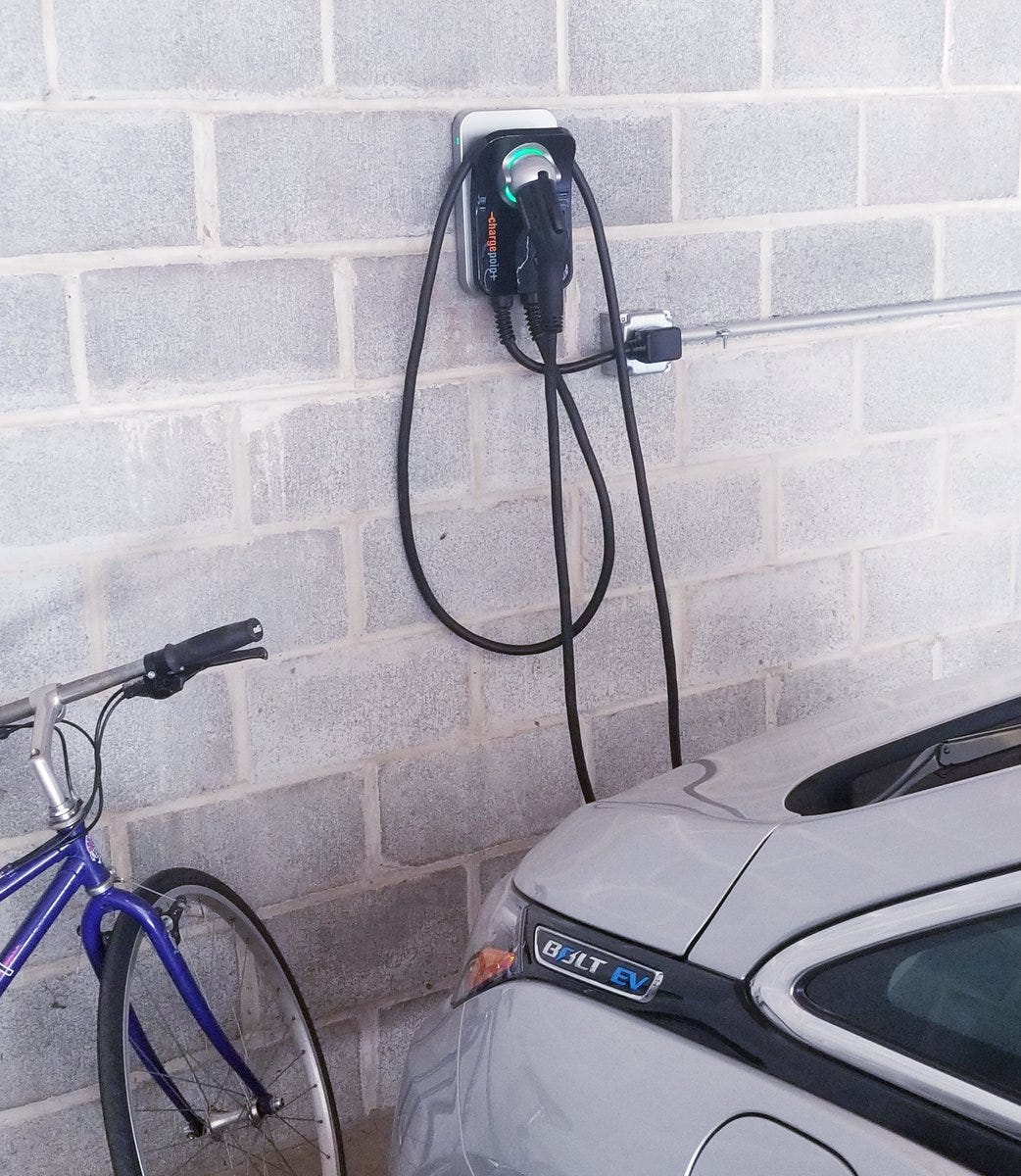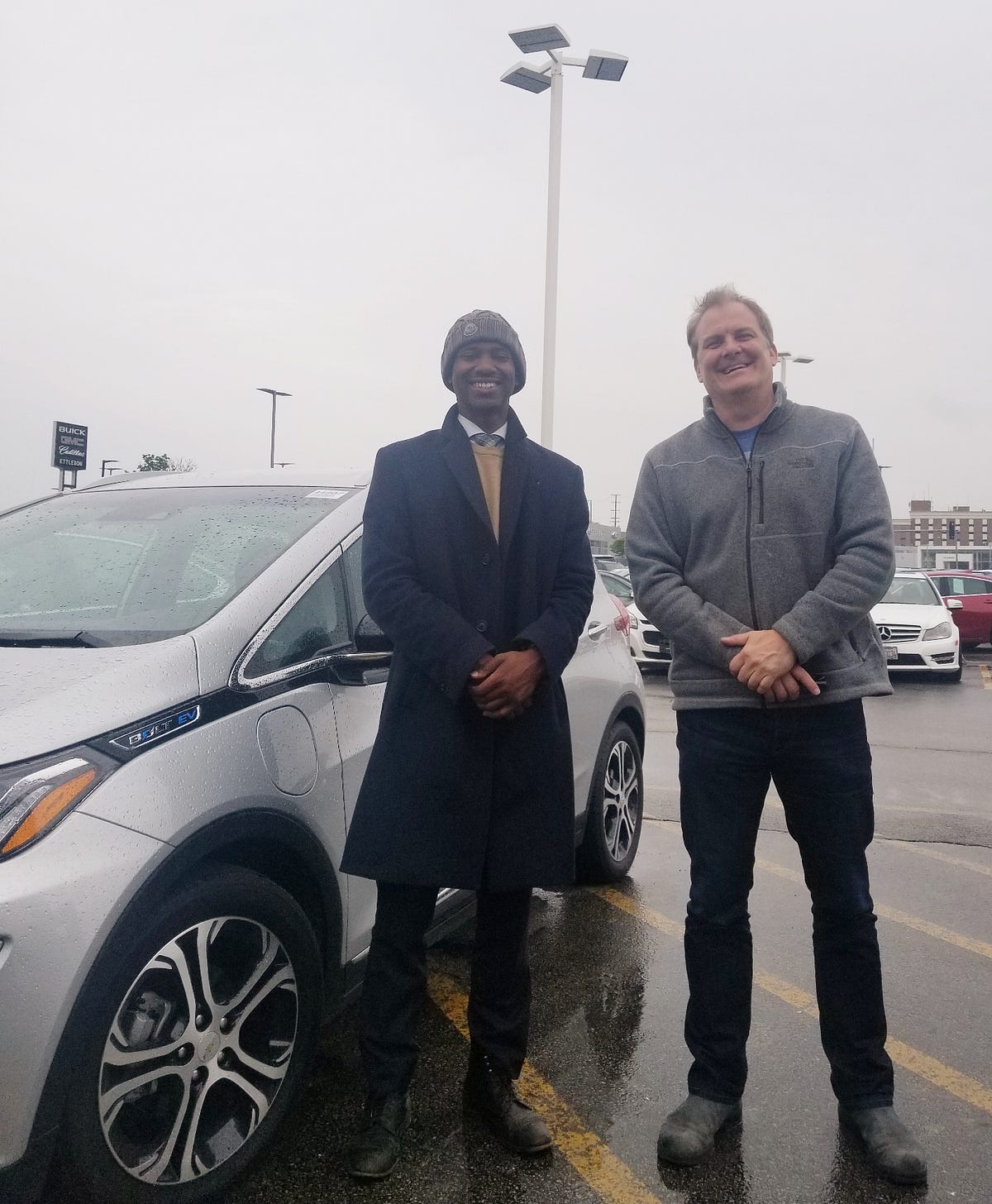for Medium.com by David Kolata, CUB’s Executive Director
I could say I’m pumped — but that’s not quite right, given that I’ve bypassed the gas station. Maybe ‘juiced’ is a better way to describe how I feel about my first electric vehicle (“EV”), a 2018 Chevy Bolt.

The new 2018 Chevy Bolt and Chargepoint Level 2 home charger. Bike poised in attempt to mask hideous garage aesthetics.
After fourteen years with a less-than-fuel-efficient car, it was time to make a change. And I’m not the only one making the switch. Transportation experts and financial analysts predict that EV ownership will boom over the next decade, as battery prices decline.
Why did I choose to buy an electric vehicle? Well, to start, EVs are fast, fun to drive, and far less expensive to maintain than conventional gasoline-powered cars. With fewer mechanical parts, there are fewer looming repair needs. Meanwhile, the cost of fully charging a car with electricity is the equivalent of paying approximately $1 for a gallon of gas (the cost-comparison varies marginally depending on the state) — prices not seen here since the early 1980s.
And the savings can be exponentially greater in regions where EV owners can choose a time-variant pricing plan through their electric utility. These plans allow drivers to capitalize on periods of the day when electricity prices are lowest. Charging an EV during these intervals can be extraordinarily cheap and, in some cases, you can actually earn money by charging in hours when electricity prices go negative.
My experience so far driving the Chevy Bolt is instructive. I purchased the car in May and drove about 300 miles during the month, which would have cost about $50 in gas with Chicago prices. On ComEd standard rates it would have cost me $9 to travel this distance (great savings!). But, in fact, I paid roughly $4.60 to drive 300 miles because I’m on ComEd’s fantastic real-time pricing program (even greater savings!)

This is Maurice. He loves real-time electricity pricing and says it’s a winning combination with EVs.
In addition to being cheaper to own and operate, electric vehicles are better for the environment, reduce global warming pollution and our dependence on foreign oil, and help improve air quality with their zero-emission batteries. Less known, but just as important, is the ability for EVs to improve the efficiency of our shared electricity grid. That’s the subject the Citizens Utility Board explored in our ABC’s of EVs guide on principles and policies that regulators should adopt to ensure all consumers benefit from the burgeoning wave of electric vehicle ownership, even those who don’t drive or own an EV.
But it is one thing to help drive the debate on EV policy, and it’s another to drive an EV. Fortunately, my journey from analyst to motorist has been fun — largely surpassing expectations. Here is a quick review of my electric vehicle ownership journey so far:
The Buying Experience
In searching for a new car, we were replacing a 14-year-old Subaru; at our house, we put a premium on performance and durability. After researching reviews, we targeted the Chevy Bolt, the 2017 Motor Trend car of the year. Though some online chatter suggests that the reduced maintenance needs associated with EVs makes car dealers reluctant to sell them, we encountered no resistance when we hit the market. The sales experience was solid. We solicited several dealers online, and most were responsive, particularly Advantage Chevrolet of Hodgkins, where we ultimately purchased the Bolt. Scheduling a test drive was easy. Price negotiations were no different than bargaining over a traditional car — which is to say a bit annoying.

This is me with Josh, the salesperson who sold us the Chevy Bolt.
Altogether, browsing and purchasing an EV was no more cumbersome than shopping for any other car. Given the rapid progress in battery technology, we chose to lease the car rather than purchase outright.
The Charging Experience
While EV batteries can be charged by plugging into a conventional household electric outlet, refueling times can be lengthy, sometimes as much as a full day to juice the car to full capacity. To curb charging times considerably, consumers can purchase what’s known as a Level 2 Charger that uses 240V, like what an electric dryer or oven uses. This technology uses your home’s electricity supply, but requires a special charging portal that can be purchased for around $500 from a variety of manufacturers.
After researching our options, we bought a plug-in charger produced by Chargepoint. It costs a bit more than competitors, but we were drawn by its capability to sync with real-time pricing, a critical money-saving amenity for those of us who live in Illinois. We also liked the look of the Chargepoint design and the app that communicates with it is easy to use.
For installation, we hired an electrician with EV experience and solid Yelp and Google reviews — it took roughly 75 minutes to install. Once complete, it took a minute to school ourselves on how to schedule a charge in advance, but once we did, the system did all the work for us. We schedule charging based on the hourly electricity prices PJM Interconnection publishes one day in advance. Our car refuels while we’re asleep — typically between 1 AM and 5 AM when electricity prices are low, often hovering around zero or even going negative. The whole process is super-easy — although it would be better if we could schedule charging based on market prices, rather than just time. With this capability, we could have charged only in the 45 hours in May when electricity prices were negative and earned money on the energy itself (if not the distribution component of the bill).
The Operating Experience
Let me say this: if sales of electric vehicles accelerate as quickly as the cars do, we’ll all be driving one soon. While not Tesla-fast, the Bolt picks up speed rapidly (0–60 in 6.3 sec.) — a real asset on the short-access ramps to Chicago-area expressways — and handles the road well.
Its interior design is functional and isn’t going to win any style awards, but there’s ample room inside. And while I’ve heard better sound systems, this one is good enough.

I liked the Bolt so much I bought the t-shirt too.
All in all, I can say that electric vehicles are a great choice for many driving needs and household budgets. At the same time, we need to remain cognizant of the cumulative impacts on the system. The expected proliferation of EVs may foreshadow a surge in demand on the electricity grid. But by expanding access to programs like real-time pricing — and an array of other measures recommended in CUB’s ABC’s of EVs policy blueprint — we can harness this surge to actually benefit our electric grid and reduce bills and rates for everyone.
Now’s the time for policymakers to get ahead of the curve. The EV revolution is in motion, and as an enthusiastic participant, I’m excited about the road ahead.

